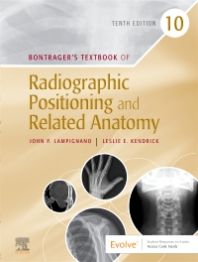|
|
|
| |
 |
|
|

|
 推薦指數:
推薦指數:





|
|
- 內容介紹
|
Bontragers Textbook of Radiographic Positioning and Related Anatomy 10th Edition
by John Lampignano MEd RT(R) (CT) (Author), Leslie E. Kendrick MS RT(R)(CT)(MR) (Author)
Publisher : Mosby; 10th edition
Language : English
Hardcover : 848 pages
ISBN-13 : 978-0323749565
Item Weight : 6.39 pounds
2021
Get the information and guidance you need to become proficient in positioning with Bontrager’s Textbook of Radiographic Positioning and Related Anatomy, 10th Edition. With a very easy-to-follow organization, this comprehensive text focuses on nearly 200 of the most commonly requested projections to ensure you master what’s expected of an entry-level practitioner. And with Bontrager’s user-friendly format featuring one projection per page — with bulleted information on the left side of the page and positioning photos, radiographic images, and anatomical drawings aligned on the right — you’ll be able to quickly and easily visualize anatomy and master positioning.
New to this edition
NEW! Updated photographs visually demonstrate the latest digital technology used in radiography with new radiographs, positioning, and equipment images.
UPDATED! The latest ARRT competencies and ASRT curriculum guidelines are incorporated to prepare students for boards and clinical practice.
NEW! Erect positions have been added throughout the text to reflect current practice.
NEW! New Bernageau and Zanca projections have been included to keep students on top of these projections performed for shoulder pathology and trauma.
UPDATED! Critique section at the end of chapters tests students’ understanding of common positioning and technical errors found in radiographs. Answer keys are provided for instructors on the Evolve website.
NEW! Information on pain management, blocks, and epidurals has been added to the Trauma, Mobile, and Surgical Radiography chapter.
UPDATED! Expanded content on fluoroscopy has been included to keep students up to date on the latest information.
Key Features
Labeled radiographs (radiographic overlays) identify key radiographic anatomy and landmarks to help students recognize anatomy and determine if they have captured the correct diagnostic information on images.
Positioning chapters organized with one projection per page present a manageable amount of information in an easily accessible format.
Unique page layout with positioning photos, radiographic images, and radiographic overlays is presented side-by-side with the text explanation of each procedure to facilitate comprehension and retention.
Clinical Indications features list and define pathologies most likely to be encountered during procedures to help students understand the whole patient and improve their ability to produce radiographs that make diagnosis easy for the physician.
Evaluation Criteria content on positioning pages describes the evaluation/critique process that should be completed for each radiographic image.
Pediatric, Geriatric, and Bariatric Patient Considerations are provided to prepare technologists to accommodate unique patient needs.
Emphasis on radiation safety practices provides recommendations important for clinical practice.
|
|
|

